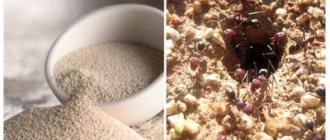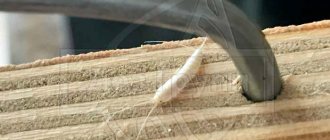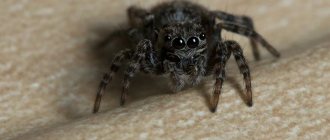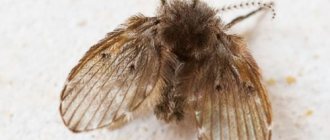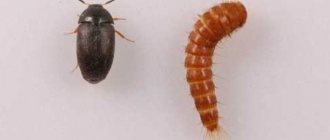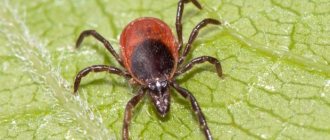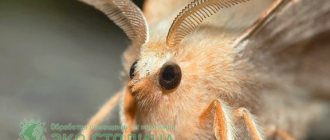Few people know what a book louse looks like and how to get rid of it at home forever. If your apartment has an old library, supplies of dried grass, herbariums or old furniture, then the risk that you will get unwanted neighbors in the form of colonies of these parasites is great. It is no coincidence that the second name of this insect is hay beetle. These small pests feed on organic plant debris and book binding paste.
The book louse is an insect of the order of hay-eaters.
Biological description of the species
The book louse (or Liposcelis divinatorius) belongs to the class of insects, the order of hay-eaters, the family of trogids (insects with rudimentary wings). They are found in the form of single individuals and culigulae (clusters).
You can distinguish hay louse from other household pests by the following features:
- size from 2 to 4 mm;
- high mobility;
- whitish-yellowish body;
- long mustache;
- 3 pairs of legs;
- thickened back;
- lack of wings in females.
The book beetle is lighter in color and smaller than the bedbug, does not fly like a moth or fruit fly, and does not have antennae on its tail like the sugar silverfish. Unlike the blood-sucking louse, it does not bite humans, and unlike the skin beetle, it does not feed on products of animal origin (meat and bone meal, dried fish, dried meat).
The hay beetle does not jump like a flea, and makes characteristic ticking sounds when it hits its head on wood dust or paper.
The greatest similarity is with the dust louse (Trogium pulsatorium), which belongs to the same synanthropic species. These insects can be distinguished by light spots on the forehead that imitate eyes. The dust louse has these spots, but the book louse does not.
The book louse is a small and inconspicuous insect with a round body.
Description
Enlarged photos of book lice clearly show that they have a flat, elongated body, divided into a torso and chest. This type of parasite is also characterized by the presence of 15-segmented antennae, complex eyes and sharp teeth, which are the main cause of all the damage they cause. No more than one millimeter long.
Book louse
Book eaters are hardy and very tenacious, so they can adapt to any external environment around them. In human dwellings, hay beetles settle in a variety of places:
- on shelves with books, especially likely with old publications that are rarely used;
- in places where large amounts of paper and waste paper accumulate;
- in cupboards with cereals;
- under the wallpaper;
- in old upholstered furniture or carpets.
The book louse reproduces very quickly. At one time, the female is able to lay over a hundred eggs. And throughout her life she reproduces more than six times. When they respond slowly to a problem, parasites cause serious damage. They can cause significant damage to beloved editions of old books and important documents. The female book louse and her offspring can be seen in the photo below:
Habitats
The order of hay beetles includes almost 1,000 insects of different species that live in different climatic zones around the world. Extensive areas infested by these insects are found in tropical and subtropical areas with high air humidity.
Dusty hay beetles (Troctes divinatorius) mostly live near humans or animals.
Small parasites actively breed in libraries, doghouses, bird nests, rodent burrows, haystacks and grain warehouses. They can be found in damp and cluttered rooms and damp basements. They eat mold, starchy substances and plant waste.
These bugs are rarely found in new buildings, more often in old houses and abandoned premises. They can be found in apartments where wallpaper was glued with flour paste. These are mainly old “Khrushchev” and “Stalin” buildings, in which older people live.
A detachment of hay eaters is actively breeding in libraries.
Entomologists consider temperatures of +16…+32°C and humidity above 55% to be a favorable environment for the reproduction of pests. Therefore, it is most difficult to remove hay beetles in the bathroom.
Insect species
Today, more than 5 thousand varieties of hay beetles are known. Most of them are content to live in the wild, but some have adapted to being close to humans.
In residential areas there are usually two types:
- Book louse.
- House hay eater.
Despite the visual similarity, the bugs are somewhat different from each other.
Book louse
This small beetle (about 1 mm long) has a light-colored body with a yellowish tint and a large head. The antennae exceed it in length and evenly taper towards the edges. A distinctive feature is the absence of wings.
The main habitat is bird nests and rodent burrows. Reproduction occurs without fertilization, which causes a high rate of appearance of new individuals.
A female beetle can lay up to 100 eggs per day, protecting the clutch with physiological secretions from the intestines. Under favorable natural conditions, the book hay beetle is capable of reproducing up to 6 times throughout the year.
If pests live in a residential area, this process continues without stopping.
Brown hay eater
Another name is dusty hay beetle. This is a type of insect that is as close in structure as possible to the book louse. The main difference lies in the morphological features.
The pest has a light yellow body and brown stripes on the upper half of the abdomen. Its distinctive feature is the presence of rudimentary wings (appendages of the posterior wall of the body).
The length of the dusty hay beetle is about 2 mm, which is twice the size of the book louse.
Reproduction method
The book louse develops through 3 stages of hemimetamorphosis: egg, larva and imago (mature individual). It reproduces by parthenogenesis (without prior fertilization).
The female can bear offspring 5-6 times a year. She lays 40-60 eggs per day on hard surfaces and covers the clutches with rectal secretions. After 10-12 days, the eggs hatch into larvae. It takes nymphs 21 to 28 days to reach the adult stage.
The rate of maturation depends on temperature and humidity. The higher they are, the faster the parasite grows. Under favorable conditions, 75-80% of the offspring survive. And after a month, new adults are ready to reproduce.
Troctes divinatorius live on average 45 to 50 weeks, and females can lay eggs throughout their lives. Even a single masonry can infect large areas of premises. Therefore, it is important to get rid of hay beetles as soon as they appear.
Reproduction of new individuals occurs without fertilization.
Peculiarities of book lice reproduction
Hay eaters can lay either 1 or several eggs at a time. On average, they produce up to 40 eggs in one day. The maximum number they can lay in 24 hours is 60 eggs.
Almost all eggs hatch into larvae in 99% of cases. The lifespan of an adult is related to its habitat: temperature, humidity and food availability. In the right conditions, healthy insects can live up to 53 weeks. However, even if there is no food, hay beetles can live indoors for quite a long time without it.
Reasons for appearance
Many housewives are confident that their home is not in danger of being infested with parasites, since it was recently built. But if a book louse appears, entomologists and sanitary and epidemiological services will advise you on how to get rid of it at home.
The book beetle appears and actively reproduces in damp, unventilated areas.
If a person does not monitor the sanitary and hygienic condition of the apartment, does not pay attention to cleaning the premises and stores large supplies of food without a refrigerator, then most likely his house will be infested with house lice. Under such conditions, hay beetles also appear in new buildings.
Struggle
Due to the fact that book louse in the house is not a widespread phenomenon, there are few traditional ways to combat it. But if it still starts up, you can try to get rid of it using mechanical methods:
- take books out into the cold, putting them in a plastic bag;
- the opposite effect is taking it out into the heat.
In addition to folk remedies, you can use modern means: fumigators near bookshelves and other insecticides.
If the population has grown and there are too many pests, you can invite SES employees. They will treat the room with wet chemicals or mist (cold or hot). Any of these methods can really get rid of the pest at any stage of its development.
But if the problem affects large premises (museums, libraries, archives, etc.), then no folk methods will save you. Here, only the sanitary and epidemiological station can resolve the situation, because for the sake of preserving valuables, only this organization will have suitable methods of destruction and special preparations, the proper calculation of which will not allow any damage.
How dangerous are hay eaters for humans?
The hay beetle harms stocks of cereals and dried vegetables. He contaminates them with the products of his vital activity: rectal secretions, skins of hatched larvae. After this, the food becomes unfit for consumption.
Some people have an allergic reaction to hay eaters.
The hay louse causes great damage to books and filing cabinets. The folios, which have become home to a colony of these pests, crumble into dust, worn away by hungry insects. This is a scourge for libraries that have a lot of old publications. The fact is that 30-40 years ago, to glue the spines of books, organic glue based on agar (algae) was used, which hay eaters enjoy eating.
Some people have an allergic reaction to Troctes divinatorius waste products. It is expressed in hay fever, itching of the skin. In severe cases, pulmonary edema is possible.
This insect poses a danger to warehouses, barns and granaries. It destroys the integrity of the grain, corroding its shell. Parasitic larvae eat the embryo from the seeds, so damaged grains do not sprout.
Hay eater: what kind of insect is it?
In tropical forests and subtropical zones you can often find a small representative of the fauna with two pairs of colorless wings, sometimes covered with dark spots, which fold on the abdomen when stationary. The size of these insects does not exceed 1 cm, but more often it ranges from 0.6 to 7 mm. Hay eaters, as representatives of this order are called, are, in biological terms, insects with incomplete metamorphosis. This means that their life cycle consists of only three stages: eggs, larvae and adults. Moreover, the larvae are externally similar to adult individuals, they are, as it were, a smaller copy of them and lead a lifestyle similar to the imago.
Some species of hay beetles have two pairs of colorless wings with thin veins
The order of hay eaters is very heterogeneous. Currently, scientists have studied more than 5 thousand species. This number includes 120 fossil remains found during paleontological expeditions. Outwardly, many species are not similar to each other, and sometimes even have more similarities with representatives of other orders. One of the clearest confirmations of this is the presence or absence of wings. In some species they are shortened, in others they are completely absent. Senoyeds are also characterized by sexual dimorphism, which is expressed in the fact that females of winged species can be either short-winged or completely wingless. Males have enlarged spherical eyes and antennae densely covered with hairs.
At the beginning of the 20th century, entomologists put forward a hypothesis according to which the ancient forms of hay eaters, who lived in animal burrows and bird nests, were the ancestors of parasitic insects - lice, lice and bedbugs. This assumption fully explains the external similarity of some species of hay beetles with the latest representatives of insects.
Certain species of hay eaters are more similar in appearance to representatives of other orders - Lice and Lice Eaters
In the wild, each species chooses the most suitable conditions for itself. This could be the bark or crowns of trees, nests of birds or other insects, dead wood or forest litter. There are even species that live under rocks. But almost always the best habitat is the presence of lichens nearby, which provide both a home and food for insects. Some species have adapted to the human environment. The most widespread are the book louse (Liposcelis divinatorius) and the house louse (Trogium pulsatorium).
In the wild, hay beetles live mainly in places with an abundance of lichens, remains of plant and animal origin
Video: hay beetles in the wild
Book louse
This species is the smallest representative of the order. Its dimensions are about 1 mm. The body is light, almost white with a yellowish or slightly brown tint, flattened in the dorsal and ventral parts, slightly widened and rounded at the back. The head is quite large. The antennae are longer than the head, gradually tapering towards the edges. Wings are completely absent.
In nature, they most often live in rodent burrows and bird nests. The food consists mainly of various remains of animal and plant origin, wood dust, rotting leaves, terrestrial algae, molds and parasitic fungi. Living tissues of higher plants are consumed extremely rarely.
Hay eater eggs can develop without fertilization, which contributes to the rapid reproduction of individuals. During the day, the female lays from 60 to 100 eggs: one or several at a time. Each clutch is covered with intestinal secretions, which dry out to form scales and perform a protective function. The larvae emerging from the eggs sometimes unite in groups, creating common web nests, or lead a solitary lifestyle. At a temperature of 16–35°C, the life cycle of hay beetles is 3–4 weeks. In one year, up to six generations are reproduced in natural conditions, and in domestic conditions, which are optimal, insects develop continuously.
Book louse is a small insect of pale brown or white color.
Dust louse, or house louse
A species close to the book louse. It differs only in morphological features. In appearance, this insect is light yellow in color with reddish-brown stripes on the upper part of the abdomen.
Dust louse is a light yellow insect with longitudinal stripes on the upper part of the abdomen
In addition, the dust louse is slightly larger than the book louse and reaches 2 mm in size. It also has appendages to the rear wall of the body - rudimentary wings.
Externally, the dust louse differs from the book louse in being larger in size.
Ways to get rid of book lice at home
SES workers tell you how to get rid of hay eaters in an apartment yourself.
You can fight them in 3 ways:
- mechanical;
- physical;
- chemical
The mechanical method involves manual cleaning of food supplies, sifting and aeration of cereals. This reduces contamination of bulk solids, but does not eliminate contamination.
You can get rid of book lice using mechanical and physical methods.
The physical method involves temperature treatment of contaminated materials. Nymphs and adults die at a temperature of +85°C. The same thing happens when the temperature drops to -5°C. Therefore, cereals, flakes, and medicinal herbs can be heated in the oven or placed in the freezer for 48 hours. The products are then mechanically processed to remove dead insects.
But in any apartment there are places that cannot be treated mechanically and physically: these are libraries, bathrooms, collections of paintings, flowers and herbs. In such cases, chemicals - insecticides - will help. Residential and warehouse premises are treated using fumigation, aerosol disinfestation and spraying with phosphine-based anti-gray beetles.
The chemical treatment method guarantees the destruction of not only adults, but also eggs with a remedy for hay beetles. Chemical destruction of pests must be carried out by employees of the sanitary and epidemiological service. Uncontrolled use of pesticides is dangerous to life and health.
How to get rid of hay beetles in an apartment: proven methods of control
Even in an apartment building, a person often has intrusive neighbors in the form of various insects. Most of them do not directly harm people, but create a lot of problems, rendering products or things unusable. Among them, you can most often see spiders, cockroaches, and mosquito flies.
Hay eaters are much less common in apartments. But if they have settled in the house, they will create a lot of problems, especially if you are the owner of a large library or a nature lover who collects herbariums. Without fighting this annoying beetle, you won’t be able to keep your treasures safe and sound.
Features of hay eaters
Hay beetles can appear both in an old house and in a newly occupied building. They especially like new block buildings. In these houses there is always high air humidity combined with high temperature, and this is the microclimate that is ideal for harmful bugs.
It promotes the development of mold, and this is one of the main types of food for them. What types of hay beetles live in residential areas and what attracts them there?
Insect species
There are more than 5.5 thousand species of these insects. Fortunately, the vast majority of them prefer to live in wildlife and do not seek to move into human housing. Hay eaters feed on a variety of plant remains, do not disdain algae, molds and lichens, and only occasionally eat parts of higher plants.
Among the inhabitants of the wild, there are also unfortunate exceptions that have chosen to live in apartments and houses: the book and dusty hay beetles. Sometimes they are also called dusty and book louse for their distant resemblance to this bloodsucking insect. Biologically they are distant relatives. The following photo gives an idea of how hay eaters behave in an apartment.
Appearance
The book louse or brownie louse is very small. The size of adult individuals does not exceed 1 mm. It can only be seen in detail in an enlarged photo. It clearly shows that its body consists of segments and has a clear division into the chest, abdomen and head with long thread-like antennae consisting of individual segments.
Hay eater size
The body color may vary depending on the habitat: yellowish, whitish or light brown. The dust louse has no wings at all, but 3 pairs of thin running legs with a jointed structure are well developed, so the bug can move quickly. The mouthparts are gnawing and well developed.
Slightly larger than the previous type, the dusty louse or dusty louse. It can be seen in this photo. This insect has a size of up to 2 mm, an elongated, slightly hairy body with rudiments of wings also covered with hairs.
A characteristic feature is reddish spots in the upper part of the abdomen, merging into longitudinal stripes. Capable of moving quickly. It has a gnawing type mouthparts. It can make a quiet, peculiar ticking sound that occurs when the insect hits the front of its head against a hard object - a sheet of paper or wood.
Both species reproduce in two ways - with and without fertilization. One female can lay up to 100 eggs over the entire life cycle. The nymphs that emerge from them quickly become adults, going through about 6 molting cycles. In nature, only the eggs of domestic hay beetles are capable of overwintering.
In room conditions at favorable temperatures, reproduction occurs continuously. Both species can live in colonies or alone. The oviposition of hay beetles is covered either with the feces of females or with a thin cobweb, which is secreted by special organs located in the mouth of the insect.
Damage caused by insects
It depends on where it decides to settle.
- If book or dust lice live in a library, their target is books. They especially love old editions, the spine of which is glued with paste. The photo shows how the hay eaters “worked” on the old publication;
- In the archive, these insects will not disdain old papers and documents;
- When living in granaries or in an ordinary kitchen, they actively damage the grain and cereals in them, leaving traces of their vital activity, which makes the products unsuitable for food and the grain unsuitable for sowing;
- In the museum, hay beetles damage exhibits and are very fond of settling in herbariums and insect collections, turning them into dust;
- In old houses they prefer to settle along heating pipes or in carpets; in new buildings they are attracted by the smells of paste, casein glue, and tile grout;
- In pots with house flowers, they feed on plant debris and do not cause much harm to indoor plants.
Harm of the hay eater
Hay eaters can go without food for a long time and easily adapt to new foods.
Harm to humans comes not only from the vital activity of these insects, but also from its products: excrement, chitinous scales left over from molting. For many people, they can become an allergen with all the ensuing consequences. Therefore, it is necessary to fight hay eaters.
How to get rid of hay eaters in an apartment
It is difficult to notice this insect immediately after its appearance due to its small size.
Spoiled food or books make you wary. If the culprit of the damage is identified, the fight begins immediately. There are several ways to get rid of these insects.
Chemicals
How to get rid of hay eaters in an apartment? The simplest thing is to call specialists to your home who will carry out professional pest control.
They usually use the following means:
- treatment using cold or hot fog;
- disinsection with chemical solutions.
To get rid of hayworms at home, you can use chemicals yourself. Only drugs of hazard classes 3 and 4 are suitable for enclosed spaces.
Which ones are most effective?
Chemical remedies for hayworm
- Flicid. This drug is made on the basis of plant raw materials - Caucasian chamomile pyrethrum. White spirit is used as a solvent, which evaporates quickly. The drug belongs to the class of pyrethroids and has a paralytic effect on insects. One treatment is not enough, so they will have to be carried out several times. When using, you must remember that the substance is flammable and spraying it in the presence of an open flame is unacceptable;
- Akarin, Vertimek, Fitoverm are insectoacaricides based on the drug avermectin. They destroy not only adults, but also eggs;
- Corsair, Ambush, City are prepared on the basis of permethrin, and Arrivo, Nurel, Sherpa are based on its isomer - cypermethrin. They have a contact-intestinal effect;
- Sprays designed to combat fleas also work well against hay eaters. To get rid of them, Get, Cucaracha, and Flea Executioner are suitable.
If you don’t want to use “chemicals” in your home, you can try folk remedies.
Traditional methods
How to get rid of hay eaters in an apartment using folk methods? Using mechanical force. Since the temperature range in which hay beetles are able to exist is small - only 16-35 degrees, the temperature is either lowered by freezing infected items in the freezer, or increased by exposing books wrapped in plastic, etc., to the sun. It is clear that this needs to be done in the summer.
Preventing the appearance of hayworms in the house
In order not to cause yourself additional trouble in the future, you just need to prevent hay eaters from appearing in your house. To do this, observe the following preventive measures:
- humidity in the house should not be higher than 50%;
- carry out thorough cleaning of the room, avoiding the accumulation of dust;
- do regular ventilation;
- care for indoor flowers;
- put order on bookshelves, wiping books and looking through them, this also applies to old documents;
- prevent mold and mildew from appearing in the apartment;
- check the condition of dried herbs and berries, collections and herbariums;
- throw away expired cereals and other dry foods;
- do not clutter the house with unnecessary things.
Conclusion
The presence of insects in the house is always unpleasant. To avoid this and not bother yourself with measures to remove them, you need to follow all preventive measures.
Book louse: how to get rid of it?
Since these parasites are extremely rare in homes, there are no special measures for their destruction, however, there are a number of preventive measures that will help get rid of these enemies.
First of all, it is necessary to constantly wet clean all rooms of the apartment. Particular attention should be paid to bookshelves. If there are a large number of herbariums or dried flowers in the room, then they need to be periodically updated or cleaned of dust. In the kitchen, it is imperative to promptly sort out all old cereals, as well as expired products. If there are already too many hay eaters and they cause great inconvenience, then only pest control of the apartment or treatment with specialized compounds will help. To do this you will have to call the SES.
There are several methods used by experienced specialists. In some situations, refrigerant is used, which freezes insects. In more difficult situations, treatment is carried out with a wet insecticide. For comprehensive destruction of parasites, cold or hot fog is used using the latest generation of non-toxic chemicals. Thanks to pest control of your apartment, you can forget about unpleasant and annoying neighbors forever.
Natural enemies of lice
Photo: What a louse looks like
The enemies of lice are the people who fight them. Classic dip and spray concentrates of traditional contact insecticides (mainly organophosphates, synthetic pyrethroids and amidines) are quite effective lacicides for cattle. However, such insecticides do not kill lice eggs (nits), and their residual effect is usually not sufficient to ensure that immature lice are killed when the eggs hatch.
A variety of compounds are effective in controlling lice in cattle, including the following:
- synergized pyrethrins;
- synthetic pyrethroids;
- cyfluthrin;
- permethrin;
- zeta-cypermethrin;
- cyhalothrin (including gamma and lambda cyhalothrin, but only for cattle).
Many pyrethroids are lyophilic, facilitating the development of pour-on formulations with good distribution. Natural pyrethrins degrade quickly, while synthetic pyrethroids such as flumethrin and deltamethrin are more stable and have a relatively long duration of action, but they do not affect all stages of the lice life cycle.
Organophosphates such as phosmet, chlorpyrifos (for beef and non-lactating dairy cattle only), tetrachlorvinphos, coumaphos, and diazinon (for beef and non-lactating dairy cattle only) are also used against lice.
Compounds such as macrocyclic lactones, ivermectin, eprinomectin and doramectin are used to control lice in cattle. Injectable macrocyclic lactones also control lice bites as they reach the parasites through the host's bloodstream. But control of chewing lice is usually incomplete. Medicinal formulations are effective against lice bites, while injectable formulations are primarily effective against blood-sucking lice.
Is it necessary to get rid of these insects?
If the unpleasant bugs don’t bother you, then you don’t have to get rid of them. The fact is that these insects are not carriers of the disease, they do not bite and will not crawl into bed or onto clothes. By and large, the only trouble they bring is their unsightly appearance, since no one will like it if bugs move around his apartment. They can also interfere if they start eating millet and other groups that are in the kitchen.
We can conclude that the hay beetle does not pose a great danger to humans. This parasite does not spoil things (except books) and does not emit an unpleasant odor. Therefore, whether to get rid of them or not is up to everyone to decide for themselves. It all depends on the number of insects and whether they are visible to the human eye.

